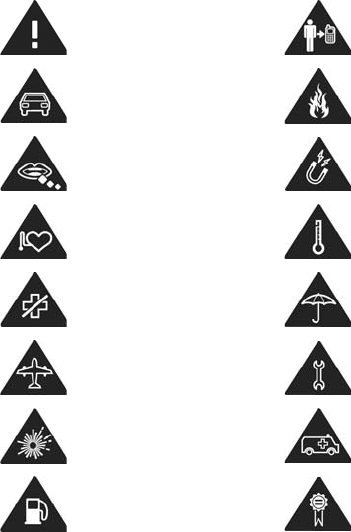ZTE R203-Z Vodafone Mobile Wi-Fi User Manual R203 Z Mobile Wi Fi PSI 0112 en GB indd
ZTE Corporation Vodafone Mobile Wi-Fi R203 Z Mobile Wi Fi PSI 0112 en GB indd
ZTE >
Contents
- 1. user manual 1
- 2. user manual 2
user manual 2
Safety Manual
Vodafone Mobile Wi-Fi
R203-Z
RF Exposure 5
Specifi c Absorption Rate (SAR) 5
Body worn operation 5
CE Approval (European Union) 6
FCC Statement 6
FCC Compliance 6
Distraction 8
Driving 8
Operating machinery 8
Product Handling 8
Small Children 9
Air Bags 9
Emergency Situations 10
Device Heating 10
WEEE Approval 10
Electrical Safety 10
Accessories 10
Connection to a Car 10
Faulty and Damaged Products 11
Table of contents
Interference 11
Pacemakers 11
Hearing Aids 11
Medical devices 12
Hospitals 12
Aircraft 12
Interference in cars 12
Explosive environments 13
Petrol stations and explosive atmospheres 13
Blasting Caps and Areas 13

Read the Safety
Information section of this
safety manual on page 5
Do not use hand-held
while driving
Small parts may cause a
choking hazard
Keep away from
pacemakers and other
personal medical devices
Switch off when
instructed in hospitals and
medical facilities
Switch off when
instructed in aircrafts and
airports
Switch off in explosive
environments
Do not use while
re-fuelling
For body-worn operation
maintain antenna
separation of 1.5 cm
Do not dispose of in
a fi re
Avoid contact with
magnetic media
Avoid Extreme
Temperatures
Avoid contact with
liquid, keep dry
Do not try and
disassemble
Do not rely on this
device for emergency
communications
Only use approved
accessories
Safety Information
5
RF Exposure
Your device contains a transmitter and a receiver. When it is ON, it receives and transmits
RF energy. When you communicate with your device, the system handling your
connection controls the power level at which your device transmits.
Specifi c Absorption Rate (SAR)
Your wireless device is a radio transmitter and receiver. It is designed not to exceed the limits
for exposure to radio waves recommended by international guidelines. These guidelines
were developed by the independent scientific organisation ICNIRP and include safety
margins designed to assure the protection of all persons, regardless of age and health.
The guidelines use a unit of measurement known as the Specifi c Absorption Rate, or SAR.
The SAR limit for wireless devices is 2 W/kg and the highest SAR value for this device when
tested complied with this limit.
Body worn operation
Important safety information regarding radio frequency radiation (RF) exposure
To ensure compliance with RF exposure guidelines the device must be used with a
minimum of 1.5 cm separation from the body.
Failure to observe these instructions could result in your RF exposure exceeding the
relevant guideline limits.
is 1.13 W/kg
The highest SAR value for this model device as reported to the FCC when worn on the body,
Safety Information
6
CE Approval (European Union)
The wireless device is approved to be used in the member states of the EU. ZTE declares
that the wireless device is in compliance with the essential requirements and other
relevant provisions of the Radio and Telecommunications Terminal Equipment Directive
1999/5/EC (R&TTE Directive).
FCC Statement
FCC Compliance
Federal Communications Commission Notice (United States): Before a wireless device
model is available for sale to the public, it must be tested and certifi ed to the FCC that it
does not exceed the limit established by the government-adopted requirement for safe
exposure.
The SAR limit for battery operated standalone wireless routers adopted by the USA and
Canada is 1.6 watts/kilogram (W/kg) averaged over one gram of tissue. The highest SAR
value reported to the FCC and IC for this device type was compliant with this limit.
Safety Information
7
This device complies with part 15 of the FCC Rules. Operation is subject to the condition
that this device does not cause harmful interference.
Caution: Changes or modifications not expressly approved by the manufacturer could
void the user’s authority to operate the equipment.
NOTE: This equipment has been tested and found to comply with the limits for a Class B
digital device, pursuant to part 15 of the FCC Rules. These limits are designed to provide
reasonable protection against harmful interference in a residential installation. This
equipment generates, uses and can radiate radio frequency energy and, if not installed
and used in accordance with the instructions, may cause harmful interference to radio
communications. However, there is no guarantee that interference will not occur in a
particular installation. If this equipment does cause harmful interference to radio or
television reception, which can be determined by turning the equipment off and on, the
user is encouraged to try to correct the interference by one or more of the following
measures:
• Reorient or relocate the receiving antenna.
• Increase the separation between the equipment and receiver.
• Connect the equipment into an outlet on a circuit different from that to which the
receiver is connected.
• Consult the dealer or an experienced radio/TV technician for help.
Safety Information
8
Distraction
Driving
Full attention must be given to driving at all times in order to reduce the risk of an
accident. Using this device while driving causes distraction and can lead to an accident.
You must comply with local laws and regulations restricting the use of wireless devices
while driving.
Operating machinery
Full attention must be given to operating the machinery in order to reduce the risk of
an accident.
Product Handling
You alone are responsible for how you use your device and any consequences of its use.
You must always switch off your device wherever the use of a mobile phone is prohibited.
Do not use the device without the clip-on covers attached, and do not remove or change
the covers while using the device. Use of your device is subject to safety measures
designed to protect users and their environment.
• Always treat your device and its accessories with care and keep it in a clean and dust-
free place.
• Do not expose your device or its accessories to open fl ames or lit tobacco products.
• Do not expose your device or its accessories to liquid, moisture or high humidity.
• Do not drop, throw or try to bend your device or its accessories.
• Do not use harsh chemicals, cleaning solvents, or aerosols to clean the device or its
accessories.
Safety Information
9
• Do not paint your device or its accessories.
• Do not attempt to disassemble your device or its accessories, only authorised
personnel must do so.
• Do not expose your device or its accessories to extreme temperatures, minimum –5
and maximum +55 degrees Celsius. For optimal performance operate within a range of
minimum 0 and maximum +35 degrees Celsius.
• Do not use your device in an enclosed environment or where heat dissipation is poor.
Prolonged use in such space may cause excessive heat and raise ambient temperature,
which will lead to automatic shutdown of your device or the disconnection of the
mobile network connection for your safety. To use your device normally again after
such shutdown, cool it in a well-ventilated place before turning it on.
• Please check local regulations for disposal of electronic products.
• Do not carry your device in your back pocket as it could break when you sit down.
• Do not operate the device where ventilation is restricted - for example, do not operate
inside a jacket pocket, inside a handbag or in any confi ned space.
Small Children
Do not leave your device and its accessories within the reach of small children or allow
them to play with it.
They could hurt themselves or others, or could accidentally damage the device.
Your device contains small parts with sharp edges that may cause an injury or which
could become detached and create a choking hazard.
Air Bags
Do not place this device in the area over an air bag or in the air bag deployment area.
Store the device safely before driving your vehicle.
Safety Information
10
Emergency Situations
This device, like any wireless device, operates using radio signals, which cannot guarantee
connection in all conditions. Therefore, you must never rely solely on any wireless device
for emergency communications.
Device Heating
Your device may become warm during charging and during normal use.
WEEE Approval
The wireless device is approved to be used in the member states of the EU. ZTE declares
that the wireless device is in compliance with the essential requirements and other
relevant provisions of the Waste Electrical and Electronic Equipment Directive 2002/96/
EC (WEEE Directive).
Electrical Safety
Accessories
Only use approved accessories.
Do not connect with incompatible products or accessories.
Connection to a Car
Seek professional advice when connecting a device interface to the vehicle electrical system.
Safety Information
11
Faulty and Damaged Products
Do not attempt to disassemble the device or its accessory.
Only qualifi ed personnel must service or repair the device or its accessory.
If your device or its accessory has been submerged in water, punctured, or subjected
to a severe fall, do not use it until you have taken it to be checked at an authorised
service centre.
Interference
Care must be taken when using the device in close proximity to personal medical devices,
such as pacemakers and hearing aids.
Pacemakers
Pacemaker manufacturers recommend that a minimum separation of 15 cm be
maintained between a device and a pacemaker to avoid potential interference with
the pacemaker.
Hearing Aids
People with hearing aids or other cochlear implants may experience interfering noises
when using wireless devices or when one is nearby.
The level of interference will depend on the type of hearing device and the distance
from the interference source, increasing the separation between them may reduce the
interference. You may also consult your hearing aid manufacturer to discuss alternatives.
Safety Information
12
Medical devices
Please consult your doctor and the device manufacturer to determine if operation of
your device may interfere with the operation of your medical device.
Hospitals
Switch off your wireless device when requested to do so in hospitals, clinics or health
care facilities. These requests are designed to prevent possible interference with sensitive
medical equipment.
Aircraft
Switch off your wireless device whenever you are instructed to do so by airport or airline staff.
Consult the airline staff about the use of wireless devices on board the aircraft, if your device
offers a ‘fl ight mode’ this must be enabled prior to boarding an aircraft.
Interference in cars
Please note that because of possible interference to electronic equipment, some vehicle
manufacturers forbid the use of devices in their vehicles unless an external antenna is
included in the installation.

Safety Information
13
Explosive environments
Petrol stations and explosive atmospheres
In locations with potentially explosive atmospheres, obey all posted signs to turn off
wireless devices such as your device or other radio equipment.
Areas with potentially explosive atmospheres include fuelling areas, below decks
on boats, fuel or chemical transfer or storage facilities, areas where the air contains
chemicals or particles, such as grain, dust, or metal powders.
Blasting Caps and Areas
Turn off your device or wireless device when in a blasting area or in areas posted turn off
“two-way radios” or “electronic devices” to avoid interfering with blasting operations.

Safety Information
15

Safety Information
16
Product code:
R203-Z Mobile Wi-Fi PSI 01/12_en-GB